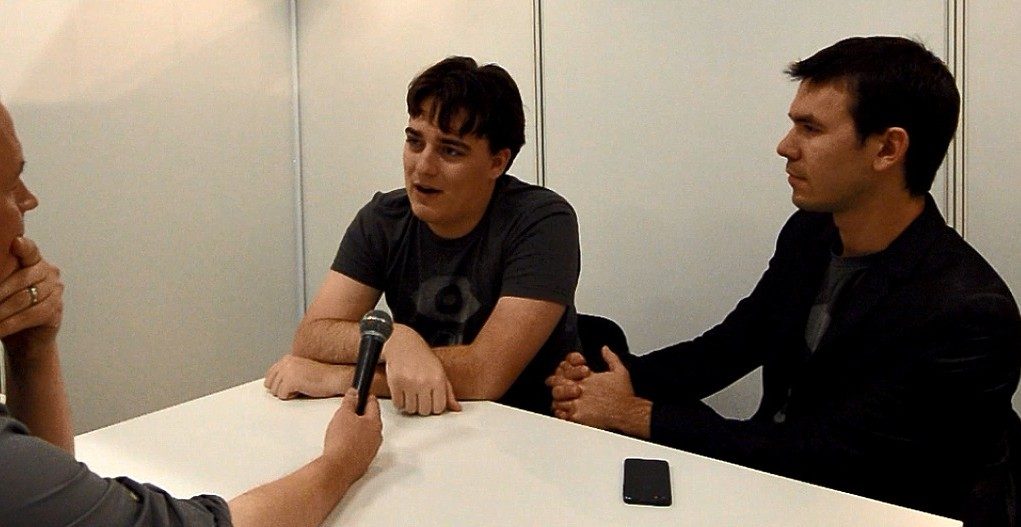At Gamescom this year I was lucky enough to be granted time with Palmer Luckey (Founder of Oculus VR) and Nate Mitchell (VP of Product) to talk all things VR. Here’s the video of that interview.
Gracious Hosts and Horrible Blunders
I’ve been fairly candid about my experiences and mishaps at GamesCom this year. My first ever shot at journalism was a challenging journey through technical mishaps and pleasant surprises. The worst blunder, unfortunately for me, occurred during my time with Palmer Luckey and Nate Mitchell at Oculus’ private business room tucked away in the corner of the Kolnmesse convention centre in Cologne, Germany.
Nate and Palmer were extremely generous with their time and patient with my limited filming experience. When the interview got started, I was pretty happy with the way things were going when, around 10 minutes in, I heard an ominous ‘click’ from the camera behind me. The camera had stopped recording seconds into the interview and the remainder completely lost. I buried the deep urge to scream “$%@!”” (and other, even less savoury things), pressed record again and after double and triple checking things were rolling we carried on. In the end, we had another interesting chat about various things and that’s what we present to you today.
The Lost Interview
What I can’t show you is the discussion around Oculus’ new content delivery and showcase website ‘Oculus Share’. We discussed what Oculus’ aims and hopes for the new platform were and Nate and Palmer stressed that the key objectives were: 1) To give developers a platform to showcase and share their work with a wider audience 2) To channel feedback for those titles back through the platform to the developers and Oculus themselves. In many ways Oculus Share is the embodiment of what Oculus have strived for since the inception of the Development Kit and the Kickstarter last year, to get the message that VR is here to as many people as possible and for those people to experiment, share and build the knowledge base for a new kind of game development.
As I’ve mentioned before, even after 12 months of flying all over the world to evangelise the Oculus Rift and the new wave of Virtual Reality the team at Oculus believe absolutely is upon us all, the enthusiasm seems entirely undiminished. Hopefully some of that comes across in the remaining interview here.
More Time with the HD Prototype
In an odd twist, my appointment with CCP Games and EVE Valkyrie immediately preceded this one, so I’d unexpectedly already tried the HD Prototypes they were proudly demoing there. Having another go however was hardly something I was going to pass up. As is now standard, I was shown different segments of the Unreal Engine 4 showcase, Elemental. The demo ran on a GTX 780 and was an impressive visual canvas to demonstrate the new 1080p panel within the prototype. Again, the superior contrast and vibrancy of the screen hit me first, blacks were inky and the red and blue hues popped brilliantly. Of course, the image was far crisper then the current Dev Kit but pixel structure is still evident. That said being able to resolve that extra detail means that middle to far distance objects and scenery are rendered properly with the added bonus of enhanced depth perception too.
Swapping between segments, Nate fired particle beams from my avatar’s POV and these in particular really illustrated just why more resolution is always a good thing in VR. They were rendered real enough to reach out and touch and again their place in 3D space much more capably rendered thanks to the extra pixels at hand.
Finally, we shifted to the Virtual Cinema demo and a 1080p trailer for the new Superman movie. I’ve already spent time watching 3D movies with the application and image clarity versus the DK1 was far superior, however, as far as I could tell the projected movie wasn’t 3D itself (although I could be wrong here). Frankly, as Home Theater nerd from way back, we still need more pixels per eye to match say an equivalent 1080p projected image in the home. Having said that, as an alternative for those (like me) who had to give up such luxuries, the ability to view a movie at this sort of perceived scale is an awesome testament to the power of VR and the possible non-gaming uses we may use it for in the future.
My thanks to Palmer (who wasn’t feeling great at all when this was filmed) and Nate for their time and patience, and apologies to the Road To VR readers for not quite bringing home all the goods this time.









